Related Research Articles
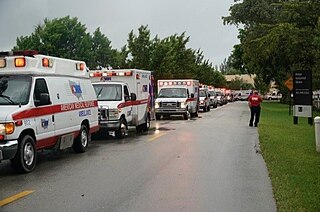
Emergency medical services (EMS), also known as ambulance services or paramedic services, are emergency services that provide urgent pre-hospital treatment and stabilisation for serious illness and injuries and transport to definitive care. They may also be known as a first aid squad, FAST squad, emergency squad, ambulance squad, ambulance corps, life squad or by other initialisms such as EMAS or EMARS.

An emergency medical technician (EMT), also known as an ambulance technician, is a health professional that provides emergency medical services. EMTs are most commonly found working in ambulances. In English-speaking countries, paramedics are a separate profession that has additional educational requirements, qualifications, and scope of practice.

A certified first responder is a person who has completed a course and received certification in providing pre-hospital care for medical emergencies. Certified individuals should have received much more instruction than someone who is trained in basic first aid and cardiopulmonary resuscitation (CPR) but they are not necessarily a substitute for more advanced emergency medical care rendered by emergency medical technicians (EMTs) and paramedics. First responders typically provide advanced first aid level care, CPR, and automated external defibrillator (AED) usage. The term "certified first responder" is not to be confused with "first responder", which is a generic term referring to the first medically trained responder to arrive on scene and medically trained telecommunication operators who provide pre-arrival medical instructions as trained Emergency Medical Dispatchers (EMD). Many police officers and firefighters are required to receive training as certified first responders. Advanced medical care is typically provided by EMS, although some police officers and firefighters also train to become emergency medical technicians or paramedics.

Hatzalah is one of several Jewish volunteer emergency medical service (EMS) organizations serving mostly areas with Jewish communities around the world, giving free medical service no matter their religion. Most local branches operate independently of each other, but use the common name. The Hebrew spelling of the name is always the same, but there are many variations in transliteration, such as Hatzolah, Hatzoloh, and Hatzola. It is also often called Chevra Hatzalah, which loosely translates as "Company of Rescuers", "Group of Rescuers", or "Rescue Squad". It is the largest volunteer medical group in the United States.

Alexandra is a town in north-east Victoria, Australia, 130 kilometres north-east of the State Capital, Melbourne. It is located at the junction of the Goulburn Valley Highway (B340) and Maroondah Highway (B360), in the Shire of Murrindindi local government area. At the 2016 census, the town had a population of 2,695 and the broader area a population of 6420.

A paramedic is a healthcare professional, providing pre-hospital assessment and medical care to people with acute illnesses or injuries. In Canada, the title paramedic generally refers to those who work on land ambulances or air ambulances providing paramedic services. Paramedics are increasingly being utilized in hospitals, emergency rooms, clinics and community health care services by providing care in collaboration with registered nurses, registered/licensed practical nurses and registered respiratory therapists.

NSW Ambulance, previously the Ambulance Service of NSW, is an agency of NSW Health and the statutory provider of pre-hospital emergency care and ambulance services in the state of New South Wales, Australia.
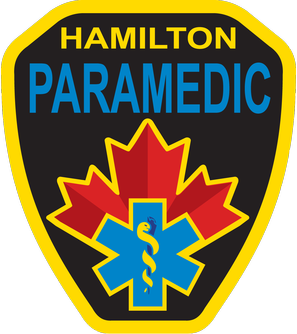
Hamilton Paramedic Service is the designated service provider for emergency medical services (ambulance) in the City of Hamilton, Ontario.

Emergency Health Services (EHS) is a branch of the Nova Scotia Department of Health tasked with providing emergency medical services. It is also responsible for transportation of patients between hospitals and medical facilities. At present, all ground ambulance and air ambulance service in Nova Scotia is contracted by EHS to Emergency Medical Care (EMC), a subsidiary of Medavie Health Services.

Yorkshire Ambulance Service NHS Trust (YAS) is the NHS ambulance service covering most of Yorkshire in England. It is one of ten NHS Ambulance Trusts providing England with emergency medical services as part of the National Health Service it receives direct government funding for its role.
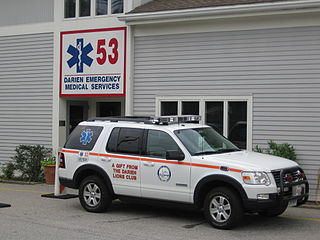
In the United States, emergency medical services (EMS) provide out-of-hospital acute medical care and/or transport to definitive care for those in need. They are regulated at the most basic level by the National Highway Traffic Safety Administration, which sets the minimum standards that all states' EMS providers must meet, and regulated more strictly by individual state governments, which often require higher standards from the services they oversee.

Australian mobile intensive care ambulances (MICA) are well-equipped ambulances staffed by highly trained paramedics dispatched to emergency situations where patients require a higher level of care than a regular ambulance can provide.
A Community first responder (CFR), is a person available to be dispatched by an ambulance control centre to attend medical emergencies in their local area. They can be members of the public, who have received training in life-saving interventions such as defibrillation, off duty paramedics, nurses or medical doctors, or indeed professionals from a non-medical discipline who may be nearby or attending emergencies, such as firefighters. Community first responders are found in the emergency healthcare systems of Canada, United Kingdom, the United States, Ireland, Israel, Italy (soccorritori), Australia, Singapore and Romania.
Emergency medical services in Australia are provided by state ambulance services, which are a division of each state or territorial government, and by St John Ambulance in both Western Australia and the Northern Territory.
Emergency medical services in New Zealand are provided by the Order of St John, except in the Greater Wellington region where Wellington Free Ambulance provides these services. Both have a history of long service to their communities, St John since 1885 and Free beginning in 1927, traditionally having a volunteer base, however the vast majority of response work is undertaken by paid career Paramedics. Strategic leadership of the sector is provided by NASO which is a unit within the Ministry of Health responsible for coordinating the purchasing and funding of services on behalf of the Ministry and the Accident Compensation Corporation.
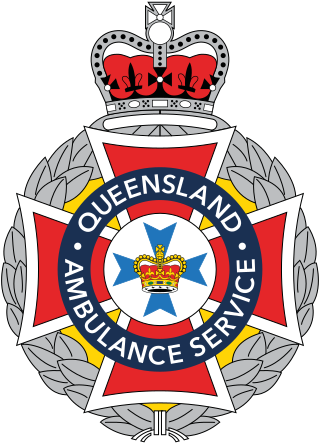
The Queensland Ambulance Service (QAS) is the state emergency ambulance and patient transport provider in Queensland, Australia. QAS is part of the Queensland Government under the Queensland Health portfolio and is one of the largest ambulance services in the world.

Ambulance Victoria (AV), a Victorian agency of the Department of Health and Human Services, is the statutory provider of pre-hospital emergency care and ambulance services in Victoria. Ambulance Victoria was formed on 1 July 2008 with the merger of the Metropolitan Ambulance Service (MAS), Rural Ambulance Victoria (RAV), and the Alexandra District Ambulance Service (ADAS). Ambulance Victoria has undergone significant reform since 2008.

Motorcycle ambulances are a type of emergency vehicle which either carries a solo paramedic or first responder to a patient; or is used with a trailer or sidecar for transporting patients. Because of its size and performance, a motorcycle ambulance is able to respond to a medical emergency much faster than a car, van, or fire truck in heavy traffic, which can increase survival rates for patients in cardiac arrest.
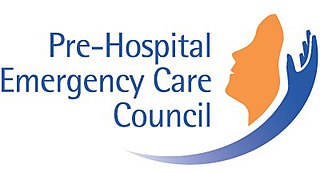
The Pre-Hospital Emergency Care Council (PHECC) is an independent statutory organisation responsible for implementing, monitoring and further developing the standards of care provided by all statutory, private and voluntary ambulance services in Ireland. It is also responsible for conducting examinations at six levels of pre-hospital care, the control of ambulance practitioner registration and the publication of clinical practice guidelines.
References
- ↑ "State ambulance services to merge". theage.com.au. 23 April 2008. Retrieved 26 April 2008.
- ↑ "Murrindindi Shire Council Directory". murrindindi.vic.gov.au. Archived from the original on 8 September 2007. Retrieved 6 June 2022.
- ↑ Community Emergency Response Teams
- ↑ Ambulance Community Officers
- ↑ Archived 27 August 2007 at the Wayback Machine Taken from the history section of the MAS website accessed 28 June 2007
- ↑ Victorian Government Health Information Website http://www.health.vic.gov.au/ambulance/index.htm accessed 27 August 2008
- ↑ 2009-10 Ambulance Victoria Annual Report Archived 12 March 2011 at the Wayback Machine accessed 27 February 2011
- ↑ http://www.mas.vic.gov.au/Main-home/What-We-Do/Operations/Area.html Archived 19 May 2009 at the Library of Congress Web Archives, retrieved 1 October 2007
- ↑ http://www.rav.vic.gov.au/What-we-do.html Archived 19 May 2009 at the Library of Congress Web Archives, retrieved 1 October 2007
- ↑ http://www.murrindindi.vic.gov.au/Directory/S2_Item.asp?Mkey=15&S3Key=26 Archived 8 September 2007 at the Wayback Machine , retrieved 1 October 2007